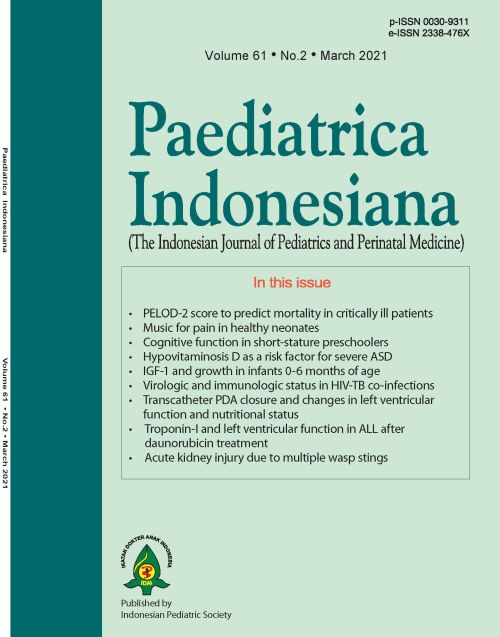Virologic and immunologic status of children with HIV-TB co-infections
Abstract
Background Studies about virologic and immunologic status of HIV children are lacking. Tuberculosis (TB) is the most common opportunistic infection in HIV patients and co-infection is associated with much worse prognosis.
Objective To describe the virologic and immunologic status of patients with HIV and TB co-infection, before and after HIV and TB treatment.
Methods A prospective study was conducted in HIV co-infected with TB patients in an Indonesian tertiary hospital between November 2016—December 2018. Viral load and CD4 levels were performed at diagnosis and after 6 months of HIV and TB treatment.
Results Of 44 children hospitalized due to HIV, 15 newly diagnosed HIV cases had TB co-infection. Thirteen were included as subjects. Most patients (10/13) were under 5 years of age, with similar female and male proportions (7/13 vs. 6/13, respectively). All were diagnosed with stage 4 HIV. Six patients had respiratory problems at admission. First examinations revealed severe immunodeficiency (CD4+ <20%) in all patients, and high viral loads (>105 copies/mL) in most (9/13) patients. Despite good compliance to medications, 8/13 patients died before the sixth month follow-up. Deterioration of virologic and immunologic status was seen in 3/4 of the followed-up patients.
Conclusion Children with HIV-TB coinfections have severe immunodeficiency and high viral loads. Most such patients die before 6 months, while survivors experience virologic and immunologic status deterioration. Future study must take into account for HIV drug resistance investigation.
References
2. Belay M, Bjune G, Abebe F. Prevalence of tuberculosis, HIV, and TB-HIV co-infection among pulmonary tuberculosis suspects in a predominantly pastoralist area, Northeast Ethiopia. Glob Health Action. 2015;8:27949. DOI: 10.3402/gha.v8.27949.
3. Ali SA, Mavundla TR, Fantu R, Awoke T. Outcomes of TB treatment in HIV co-infected TB patients in Ethiopia: a cross-sectional analytic study. BMC Infect Dis. 2016;16:640. DOI: 10.1186/s12879-016-1967-3.
4. Adejumo OA, Daniel OJ, Adebayo BI, Adejumo EN, Jaiyesimi EO, Akang G, et al. Treatment outcomes of childhood TB in Lagos, Nigeria. J Trop Pediatr. 2016;62:131–8. DOI: 10.1093/tropej/fmv089.
5. Infodatin. Situasi umum HIV/AIDS dan tes HIV. Jakarta: Pusat Data dan Informasi Kementerian Kesehatan RI; 2018. Available from: https://pusdatin.kemkes.go.id/ article/view/19042200004/situasi-umum-hiv-aids-dan-tes-hiv.html.
6. Pusat Data dan Informasi. Tuberkulosis. Jakarta: Kemenkes RI; 2018. Available from:
https://pusdatin.kemkes.go.id/article/view/18101500001/infodatin-tuberkulosis-2018.html.
7. World Health Organization. WHO case definitions of HIV for surveillance and revised clinical staging and immunological classification of HIV-related disease in adults and children. 2016. [cited 2019 July 23]. Available from: http://www.who.int/hiv/pub/guidelines/HIVstaging150307.pdf.
8. World Health Organization. Nutrition Landscape Information System (NLIS) country profile indicators: interpretation guide. Nutr Landsc Inf Syst. 2010;1–51. Available from: https://apps.who.int/iris/handle/10665/44397.
9. Widyaningsih R, Widhiani A, Citraresmi E. Ko-infeksi tuberkulosis dan HIV pada anak. Sari Pediatr. 2016;13:55. DOI: 10.14238/sp13.1.2011.55-61.
10. Turkova A, Chappell E, Chalermpantmetagul S, Negra M Della, Volokha A, Primak N, et al. Tuberculosis in HIV-infected children in Europe, Thailand and Brazil: paediatric TB-HIV EuroCoord study. Int J Tuberc Lung Dis. 2016;20:1448–56. DOI: 10.5588/ijtld.16.0067.
11. Gao J, Zheng P, Fu H. Prevalence of TB/HIV co-infection in countries except China: a systematic review and meta-analysis. PLoS One. 2013;8:e64915. DOI: 10.1371/journal. pone.0064915.
12. Gupta RK, Lucas SB, Fielding KL, Lawn SD. Prevalence of tuberculosis in post-mortem studies of HIV-infected adults and children in resource-limited settings: a systematic review and meta-analysis. AIDS. 2015;29:1987–2002. DOI: 10.1097/QAD.0000000000000802.
13. Gray JM, Cohn DL. Tuberculosis and HIV coinfection. Semin Respir Crit Care Med. 2013;34:32–43. DOI: 10.1055/s-0032-1333469.
14. World Health Organization. TB causes 1 in 3 HIV deaths. HIV/AIDS. 2018. [cited 2019 July 23]. Available from: https://www.who.int/hiv/mediacentre/ news/hiv-tb-patient-centred-care/en/.
15. Venturini E, Turkova A, Chiappini E, Galli L, de Martino M, Thorne C. Tuberculosis and HIV co-infection in children. BMC Infect Dis. 2014;14:S5. DOI: 10.1186/ 1471-2334-14-S1-S5.
16. Maher D. Chapter 3: Management of TB in the HIV-infected child. Int J Tuberc Lung Dis. 2006;10:1331–6.
17. Moolasart V, Chottanapund S, Ausavapipit J, Likanonsakul S, Uttayamakul S, Changsom D, et al. The effect of detectable HIV viral load among HIV-infected children during antiretroviral treatment: a cross-sectional study. Children. 2018;5:6. DOI: 10.3390/children5010006.
18. Korenromp EL, Williams BG, Schmid GP, Dye C. Clinical prognostic value of RNA viral load and CD4 cell counts during untreated HIV-1 infection - a quantitative review. PLoS One. 2009;4:e5950. DOI: 10.1371/journal.pone.0005950.
19. Chauhan CK, Lakshmi PVM, Sagar V, Sharma A, Arora SK, Kumar R. Primary HIV drug resistance among recently infected cases of HIV in North-West India. AIDS Res Treat. 2019;2019:1525646. DOI: 10.1155/2019/1525646.
20. Kityo C, Sigaloff KC, Sonia Boender T, Kaudha E, Kayiwa J, Musiime V, et al. HIV drug resistance among children initiating first-line antiretroviral treatment in Uganda. AIDS Res Hum Retroviruses. 2016;32:628–35. DOI: 10.1089/aid.2015.0215.
Copyright (c) 2021 Djatnika Setiabudi, Citra Cesilia, Almira Aliyannissa, Heda Melinda Nataprawira

This work is licensed under a Creative Commons Attribution-NonCommercial-ShareAlike 4.0 International License.
Authors who publish with this journal agree to the following terms:
Authors retain copyright and grant the journal right of first publication with the work simultaneously licensed under a Creative Commons Attribution License that allows others to share the work with an acknowledgement of the work's authorship and initial publication in this journal.
Authors are able to enter into separate, additional contractual arrangements for the non-exclusive distribution of the journal's published version of the work (e.g., post it to an institutional repository or publish it in a book), with an acknowledgement of its initial publication in this journal.
Accepted 2021-03-16
Published 2021-03-16













